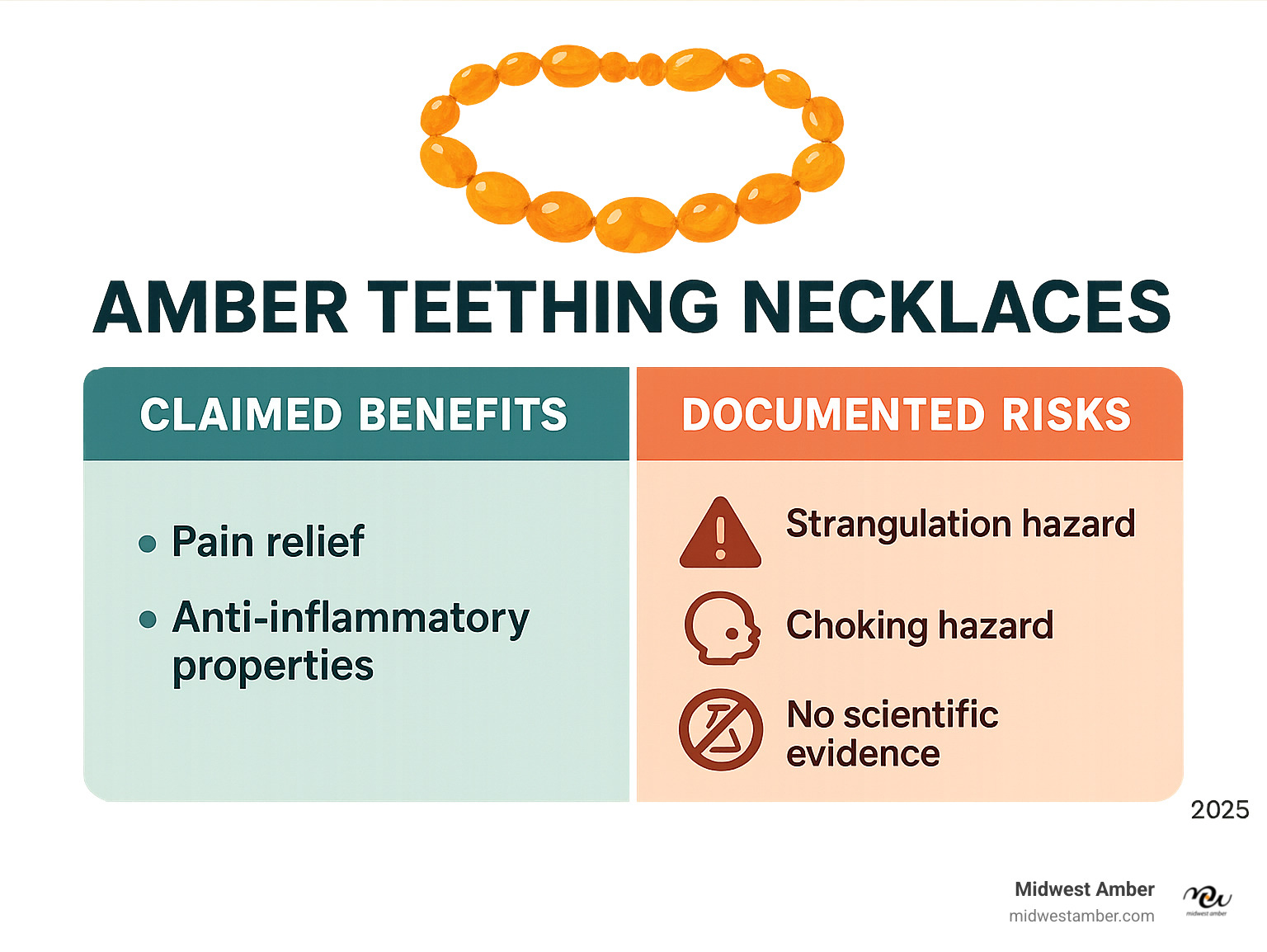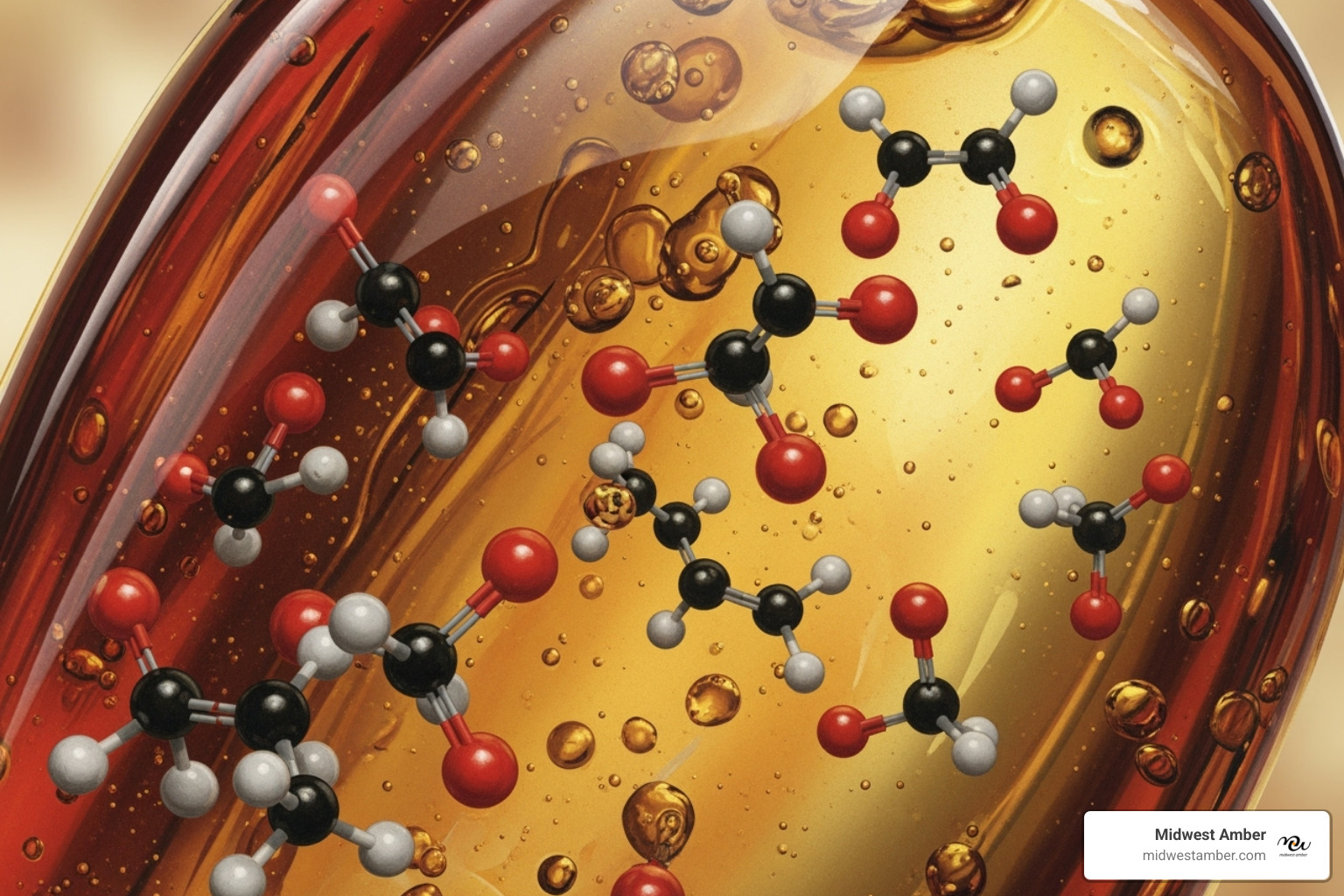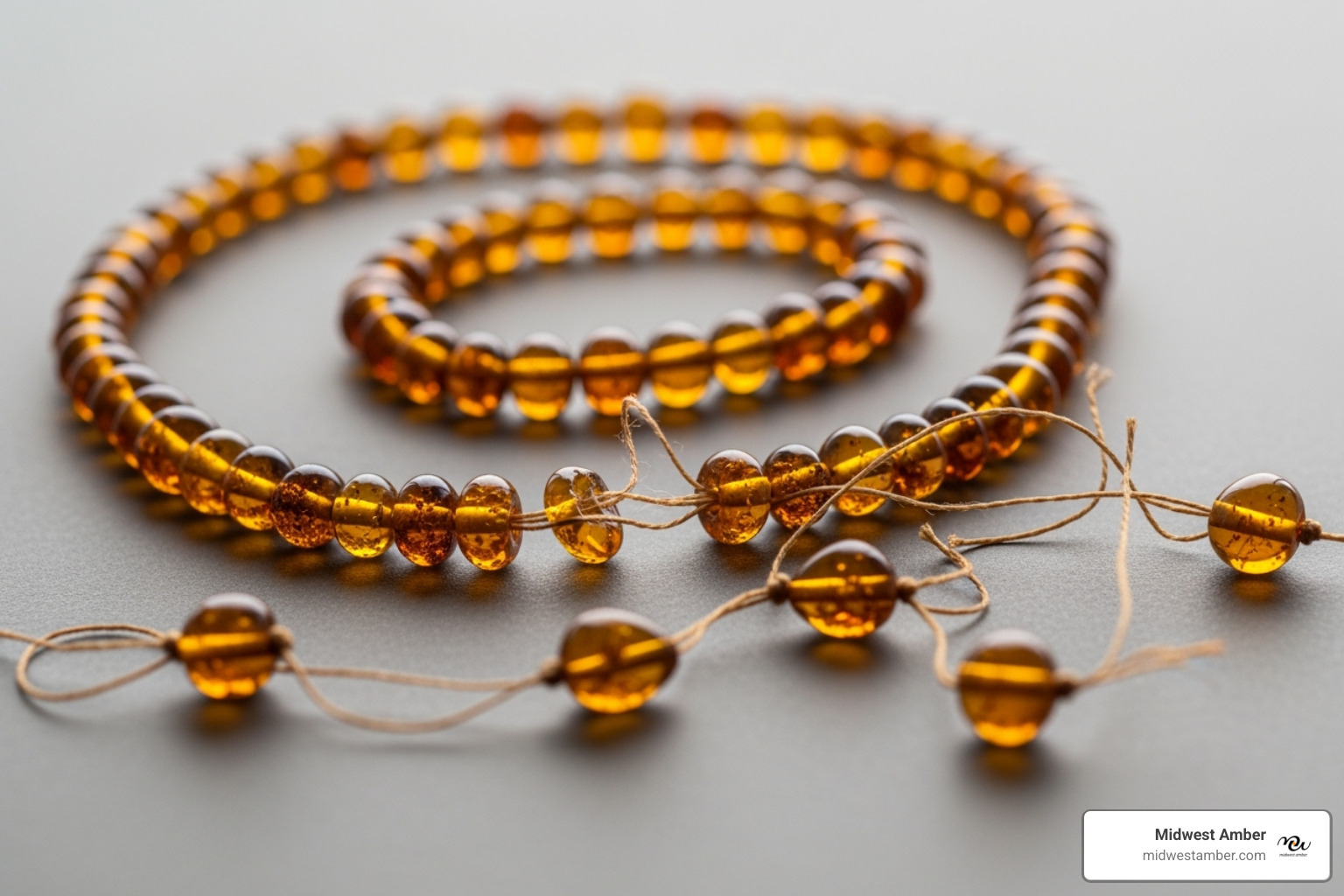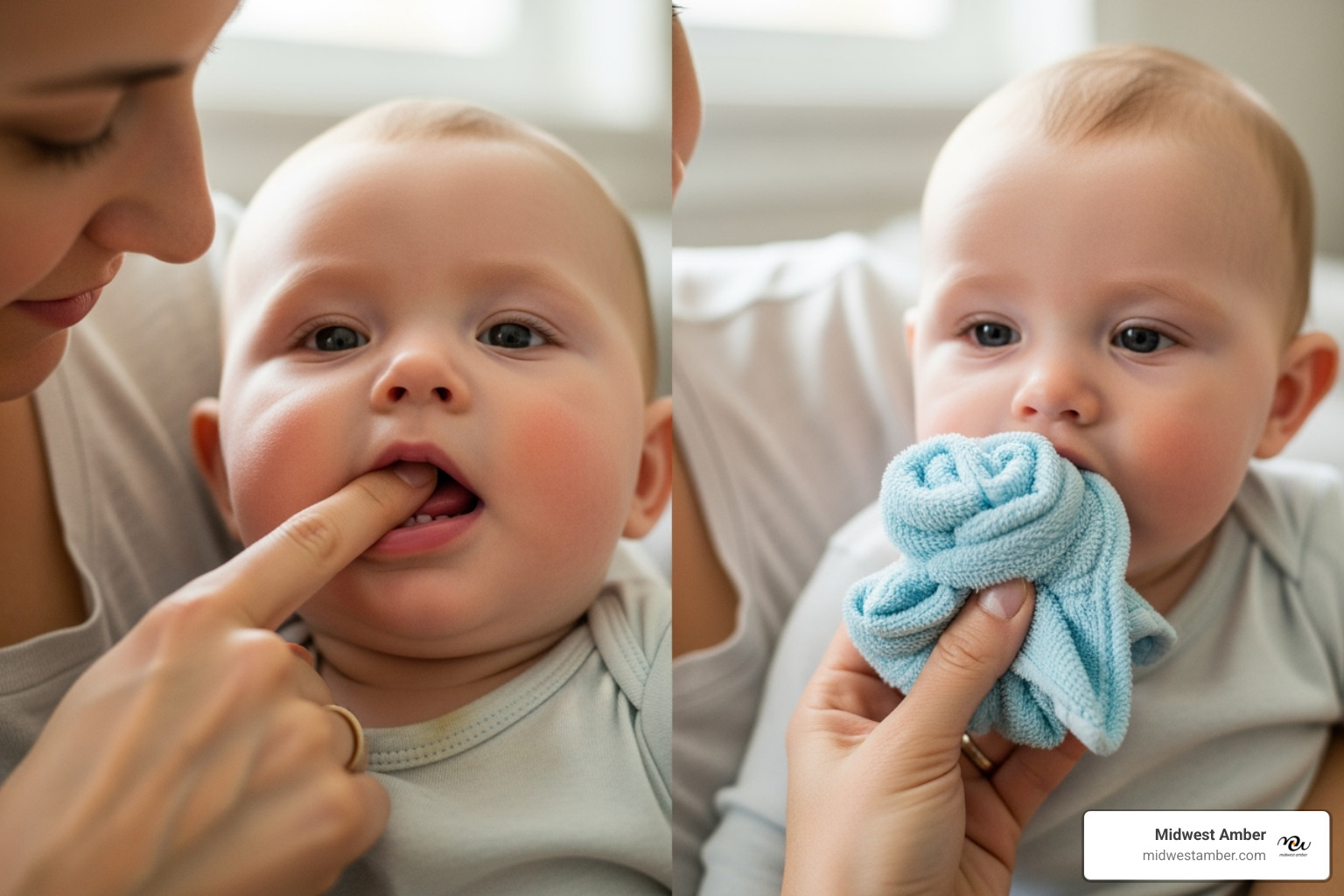Why Amber Stone Teething Necklace Safety Matters More Than Marketing Claims
Amber stone teething necklace products have become increasingly popular among parents seeking natural remedies for their baby's teething discomfort. However, the reality behind these trendy accessories is far more concerning than the marketing suggests.
Key Safety Facts About Amber Teething Necklaces:
- Strangulation Risk: Leading cause of injury-related death for children under 1 year
- Choking Hazard: Beads can break off and become lodged in airways
- No Scientific Evidence: Claims about pain relief are not supported by research
- Medical Opposition: American Academy of Pediatrics and FDA warn against use
- Temperature Requirements: Succinic acid only releases at 392°F - far beyond body temperature
The American Academy of Pediatrics does not recommend that infants wear any jewelry, and the FDA issued an official warning in December 2018 after receiving reports of children choking on beads and even the death of a toddler being strangled by the necklace while sleeping.
While parents naturally want to help their teething babies, the risks associated with these necklaces far outweigh any unproven benefits.
As Gabriel Ciupek, President and owner of Midwest Amber Inc., I've spent years working with authentic Baltic amber jewelry and understand both its genuine properties and the misleading claims surrounding amber stone teething necklace products. My experience in the amber industry has shown me the importance of separating fact from marketing fiction when it comes to child safety.

What Are Amber Teething Necklaces and How Are They Marketed?
When your little one is struggling with teething pain, it's natural to search for anything that might help. The sleepless nights and constant crying can leave even the most patient parents feeling desperate for relief. This is exactly the emotional space where amber stone teething necklace marketing thrives.
These necklaces are made from Baltic amber - which, despite the name, isn't actually a stone at all. It's fossilized tree resin that formed millions of years ago in the forests of what is now the Baltic region. The marketing around these products is incredibly compelling, especially for parents drawn to natural remedies.
The promises sound almost too good to be true: Simply place this beautiful, natural necklace on your baby, and the amber will warm against their skin, releasing healing compounds that reduce pain and inflammation. No medication needed, no fuss - just an ancient, natural solution that's been "used for centuries."
The marketing often emphasizes the "natural soothing properties" of Baltic amber, claiming it releases succinic acid when warmed by body heat. This substance is then supposedly absorbed through the skin to provide pain relief. Many parents swear by these necklaces, sharing heartfelt testimonials about reduced drooling, better sleep, and happier babies.
It's easy to understand why these claims are so appealing. When you're watching your baby suffer through teething, the idea of a simple, natural solution feels like a godsend. For parents interested in learning more about selection criteria, we offer guidance on Choosing the Right Amber Teething Necklace for Your Baby.
What is an amber stone teething necklace?
An amber stone teething necklace typically consists of small Baltic amber beads strung together on a cord. The construction usually features individually knotted beads - meaning each bead is separated by a knot so that if the string breaks, only one bead can fall off at a time. Most also have screw clasps rather than simple clasps, which marketers claim makes them safer.
Here's something important to understand: these necklaces are designed to be worn against the skin, not chewed on. The marketing explicitly states that babies shouldn't put the necklace in their mouth. Instead, the amber is supposed to work simply by touching your baby's skin as they wear it around their neck, wrist, or ankle.
The beads themselves are made from what's genuinely fossilized tree resin - not a stone despite the common name. This amber formed over 45 million years ago when ancient forests covered the Baltic region, trapping insects, plant matter, and other organic materials that we can still see today.
Raw vs. Polished Amber
When shopping for these necklaces, you'll encounter a big debate between raw versus polished amber. Advocates claim that raw, unpolished amber is more effective because it contains higher concentrations of succinic acid in its outer layer.
The argument goes like this: heat-treatment and polishing processes supposedly reduce the amber's natural properties, making it less potent for teething relief. Raw amber enthusiasts insist that only the unprocessed, naturally rough amber maintains its full "healing potential."
Polished amber, on the other hand, has been smoothed and treated to create a shinier, more jewelry-like appearance. While it might look prettier, raw amber supporters claim this processing diminishes its effectiveness for teething purposes.
This distinction has created an entire subset of marketing around "authentic" versus "processed" amber, with raw amber commanding premium prices. For those curious about distinguishing genuine amber from imitations altogether, we provide resources on Real Baltic Amber vs. Fake Amber: How to Tell the Difference.
While these marketing claims about raw versus polished amber might sound scientifically reasonable, they're part of a larger narrative that we'll examine more critically in the next section.
The Science (or Lack Thereof): Debunking the Claims
As parents, we desperately want to believe there's a simple, natural solution when our little ones are suffering through teething. The amber stone teething necklace market thrives on this hope, backed by countless glowing testimonials from other parents. But here's the hard truth: when we dig into the actual science, the foundation crumbles.
The stories you hear from friends and online reviews? They're what experts call anecdotal evidence - personal experiences that feel very real but don't prove the product actually works. Sometimes what we're seeing is the placebo effect in action. When we expect something to help our baby, we might notice improvements that were going to happen anyway or interpret normal behavior changes as "proof" the necklace is working.

The medical and scientific communities have looked for evidence supporting amber teething necklaces. What they found was... nothing. No clinical trials, no peer-reviewed studies, no scientific proof that these necklaces do anything beyond looking pretty. The gap between marketing promises and scientific reality is enormous.
This isn't just disappointing - it's concerning when parents are making health decisions for their babies based on unproven claims. If you're curious about how these myths developed over time, our article on The History and Science Behind Amber Teething Necklaces explores the fascinating backstory.
The Role of Succinic Acid
Let's talk about succinic acid - the supposed "magic ingredient" that makes amber stone teething necklace products work. Marketing materials love to highlight this compound, often calling it a natural pain reliever or anti-inflammatory agent.
Here's what's actually true: Succinic acid does exist in Baltic amber, and it is naturally present in our bodies where it plays important roles in cellular function. But the claims about how it works in teething necklaces? That's where science and marketing part ways.
The biggest problem is temperature. Succinic acid only releases from amber when heated to around 392 degrees Fahrenheit (200 degrees Celsius). To put that in perspective, that's hot enough to cause severe burns instantly. Your baby's body temperature of 98.6°F isn't even close to triggering any release of succinic acid from the amber.
Even if we ignore the temperature issue, there's zero scientific evidence that succinic acid can be absorbed through the skin in amounts that would provide pain relief. Our bodies already produce and use succinic acid naturally - there's no indication that somehow getting more from an external source would help with teething pain.
Do Amber Teething Necklaces Really Work?
The scientific consensus is crystal clear: amber teething necklaces do not work for pain relief. This isn't a matter of opinion or debate among medical professionals - it's a fact based on the complete absence of supporting evidence.
We know this might be hard to hear, especially if you've heard convincing stories from other parents. But when health organizations, pediatricians, and researchers all agree that something doesn't work, we need to listen.
What about those parent testimonials claiming the necklaces reduced drooling, improved sleep, or boosted immunity? Medical experts explain these observations in several ways: natural timing (teething symptoms come and go naturally), placebo effect (expecting improvement makes us more likely to see it), or simple coincidence (babies naturally have good days and bad days).
The bottom line? Every major health organization that has examined amber stone teething necklace claims has concluded they're unsupported by science. Instead of providing benefits, these necklaces introduce serious safety risks that we'll explore in the next section.
The Hidden Dangers of an Amber Stone Teething Necklace: Strangulation and Choking Risks
As a parent myself, I understand the desperate feeling of wanting to help your teething baby. But when it comes to the amber stone teething necklace, the safety risks are far too serious to ignore. The tragic reality is that these seemingly innocent accessories pose life-threatening dangers that no amount of claimed benefits could justify.

Strangulation is the most serious risk. Suffocation remains the leading cause of death for children under one year old, and it's among the top five causes for children ages 1 to 4. Any item around a baby's neck can become a deadly trap. The necklace can get caught on crib rails, car seat straps, or even twisted during normal movement.
The heartbreaking truth is that deaths have already occurred. An 18-month-old toddler died after being strangled by an amber teething necklace during what should have been a peaceful nap. This wasn't a manufacturing defect or improper use – it was the inherent danger of putting jewelry around a small child's neck.
Choking presents an equally serious threat. Even though manufacturers claim their beads are "individually knotted for safety," beads can still break off. Normal wear and tear, curious little fingers, or even manufacturing flaws can cause beads to detach. These small amber pieces are exactly the right size to block a child's airway completely.
The reality is sobering: what takes months of teething discomfort can become a life-threatening emergency in seconds. No parent should have to face that kind of tragedy, especially for a product that doesn't even work as advertised.
Safety guidelines for using an amber stone teething necklace
While I strongly discourage using these necklaces, I know some parents may still choose to try them despite the warnings. If you absolutely insist on using an amber stone teething necklace, these precautions are essential – though they cannot eliminate the risks entirely.
Never leave your child unsupervised while wearing the necklace. This means constant, direct adult supervision every single moment. Remove the necklace completely during naps and nighttime sleep – this is when most accidents happen. The necklace should also come off during car rides, when your child is in a crib or playpen, or anytime they might be alone even briefly.
Consider ankle or wrist placement instead of the neck if you must use one, though choking hazards from loose beads still exist. Check the necklace daily for damage – look for loose beads, fraying strings, or worn clasps. Any sign of wear means immediate disposal.
These necklaces are meant for wearing only, never for chewing. But babies explore everything with their mouths, making this guideline nearly impossible to enforce.
For more detailed safety information, please see our comprehensive guide on Safety Guidelines for Using Amber Teething Necklaces.
The bottom line? No safety precaution can make these necklaces truly safe. The risks are real, documented, and potentially fatal. When safer alternatives exist for teething relief, why take such a dangerous gamble with your child's life?
What Pediatricians and Health Organizations Say
When you're dealing with a fussy, teething baby at 2 AM, it's natural to want to try anything that might help. But here's what the medical experts want you to know: the amber stone teething necklace isn't the answer you're looking for.

The medical community's stance couldn't be clearer. Pediatricians, who dedicate their careers to keeping children safe and healthy, consistently advise against these necklaces. It's not because they're against natural remedies or want to make parenting harder - it's because they've seen the real dangers these products can pose.
The American Academy of Pediatrics takes a firm position: infants should not wear any jewelry. This isn't a suggestion or a gentle recommendation - it's a safety warning based on documented risks and tragic outcomes. When pediatricians see parents considering an amber stone teething necklace, they don't just discourage it; they explain why the risks are simply too high for any unproven benefit.
What makes this particularly heartbreaking for medical professionals is that parents are trying to help their babies, but these necklaces can actually put children in danger. The American Academy of Pediatrics warning provides detailed guidance on why these products pose unnecessary risks to your little one.
FDA and AAP Warnings
Sometimes government warnings can feel abstract, but the FDA's December 2018 warning about teething jewelry hits differently when you understand what prompted it. The agency didn't issue this warning because of theoretical risks - they acted because children were getting hurt.
The reports that reached the FDA were sobering: children choking on beads that had broken off from their necklaces. But the most devastating case involved an 18-month-old who died from strangulation while sleeping with a teething necklace on. This wasn't a manufacturing defect or improper use - this was the tragic result of what can happen when any cord or necklace is placed around a small child's neck.
The American Academy of Pediatrics doesn't mince words in their policy. They've made it clear that no jewelry belongs on infants, period. This isn't about being overly cautious or taking the fun out of cute baby accessories. It's about the reality that anything worn around a baby's neck, wrist, or ankle can become a choking or strangulation hazard in seconds.
These warnings aren't meant to scare parents - they're meant to protect children. You can read the full details in the Official FDA warning on teething jewelry to understand exactly what prompted their action.
International Health Advisories
The concerns about amber stone teething necklace products aren't limited to American health authorities. Around the world, medical experts are singing the same tune, which tells us something important: the risks are real and recognized globally.
Canada was actually ahead of the curve, with their federal public health agencies issuing warnings about these necklaces as early as 2010. They saw the potential dangers before many other countries and wanted to protect Canadian families from preventable accidents.
Ireland's Health Service Executive was even more direct in 2015, calling amber teething necklaces "inherently unsafe." That's not medical jargon - that's plain English saying these products are dangerous by their very nature, not because of how they're made or used.
This international consensus isn't a coincidence. Medical professionals worldwide are trained to evaluate risks and benefits, and when health authorities from different countries all reach the same conclusion, it's worth paying attention. The message is consistent across borders: the safety risks of these necklaces are too significant to ignore, regardless of any claimed benefits.
Safer Soothing: Tips for Comforting a Teething Baby

As a parent, watching your baby struggle with teething pain can feel overwhelming. The constant crying and sleepless nights make it tempting to try anything that promises relief, including an amber stone teething necklace. Fortunately, there are plenty of safe, effective ways to ease your little one's discomfort, methods trusted by pediatricians and generations of caregivers. For comprehensive guidance, see the Teething tips from the Mayo Clinic.
Safe Teething Comfort Strategies
- Gently massage your baby's gums with a clean finger to provide immediate counter-pressure.
- Offer a clean, chilled (not frozen) washcloth for your baby to gnaw on; the coolness naturally numbs sore gums.
- Provide safe teething rings or toys that are the right size and made from approved baby-friendly materials; chill them for extra soothing.
- Give extra cuddles, rocking, or soft singing - your presence is often the best comfort.
- Consult your pediatrician about age-appropriate pain relievers such as infant acetaminophen or ibuprofen if discomfort seems severe.
What to Avoid for Teething Pain
- Topical numbing gels containing benzocaine - the FDA warns they can cause methemoglobinemia, a rare but life-threatening condition.
- Homeopathic teething tablets - linked to seizures and breathing problems; the FDA advises discontinuing use immediately.
By sticking with proven, pediatrician-approved methods, you can help your baby weather the teething phase without introducing unnecessary risks. For details on specific product warnings, see the FDA warning on teething gels.
Frequently Asked Questions about Amber Teething Necklaces
As parents research amber stone teething necklace options, we hear the same questions over and over. Let me share some honest answers based on what we know about safety and science - not marketing claims.
Can a baby wear an amber necklace on their ankle or wrist?
Many parents ask about this thinking it's a safer compromise. I understand the reasoning - if strangulation is the main concern, maybe moving it away from the neck solves the problem, right?
Unfortunately, wearing an amber necklace on the ankle or wrist doesn't eliminate the dangers. The choking hazard remains just as serious. Babies explore everything with their mouths, and if a bead breaks off (which happens more often than you'd think), it becomes a choking risk no matter where the necklace was originally worn.
Even the "safety" features like individual knots between beads don't prevent this. One loose bead is all it takes to create a dangerous situation. While ankle or wrist placement might reduce strangulation risk, we still can't recommend it because of the very real choking dangers that remain.
Does the color of the amber matter for teething necklaces?
This is where marketing gets creative with the science. You'll see claims that honey amber is "best for teething" or that raw butterscotch amber has the "highest succinic acid content." Some sellers even suggest that darker colors like cherry or cognac amber work differently than lighter varieties.
The truth is, amber color makes no difference for teething relief - because the whole premise doesn't work in the first place. Whether it's honey, butterscotch, cherry, or any other color, all Baltic amber requires temperatures around 392°F to release succinic acid. Your baby's body temperature won't even come close to that.
The color variations you see are simply natural differences in how the tree resin fossilized millions of years ago. They're beautiful for jewelry purposes, but they don't create different "healing properties" despite what marketing materials might suggest.
Are amber teething necklaces regulated for safety?
This surprises many parents: amber stone teething necklace products aren't regulated as medical devices, even though they're marketed with health claims. The FDA doesn't test them for safety or effectiveness before they hit store shelves.
What the FDA has done is issue strong warnings against using them. The same goes for the American Academy of Pediatrics and health authorities in other countries. These aren't regulatory oversights - they're active warnings telling parents these products are unsafe.
The lack of regulation means there's no safety testing, no quality standards, and no guarantee that the product you buy meets any safety requirements. When health authorities specifically warn against a product rather than regulate it, that tells you everything you need to know about the safety concerns.
This is why we always encourage parents to stick with pediatrician-recommended teething remedies that have been properly tested and proven safe.
Conclusion
As we conclude this look at amber stone teething necklace safety, I want to be honest as a parent and someone with over two decades of experience with genuine Baltic amber.
The appeal of these necklaces is absolutely understandable. When your little one is crying from teething pain at 2 AM, the promise of a simple, natural solution feels like a lifeline. Unfortunately, the science just doesn't support the marketing claims. The succinic acid that marketers talk about only releases at temperatures around 392°F - that's hot enough to cause severe burns, not something that happens from body heat.
The safety risks, however, are very real. Strangulation remains the leading cause of death for babies under one year old. The FDA didn't issue their 2018 warning lightly - it came after documented injuries and the tragic death of an 18-month-old. These aren't theoretical risks; they're heartbreaking realities that no family should have to face.
At Midwest Amber, we're passionate about the genuine beauty and craftsmanship of Baltic amber jewelry. Our company has been working with 100% natural, ethically sourced amber from Poland and Lithuania for over 20 years, and we believe deeply in certified authenticity and quality. We love sharing the fascinating history and natural properties of this ancient fossilized resin - but only when it's used safely and appropriately.
When it comes to your child's safety, there's no room for compromise. The medical community's consensus is clear, and we stand firmly with pediatricians and health organizations who prioritize proven, safe methods over unsubstantiated claims.
Your baby's teething discomfort is temporary, but the risks from these necklaces could have permanent consequences. Trust your pediatrician, use proven comfort methods, and know that this difficult phase will pass.
Explore our collection of genuine Baltic Amber to find the true beauty of this remarkable natural material - designed for safe adult wear and appreciation.




Leave a comment
This site is protected by hCaptcha and the hCaptcha Privacy Policy and Terms of Service apply.